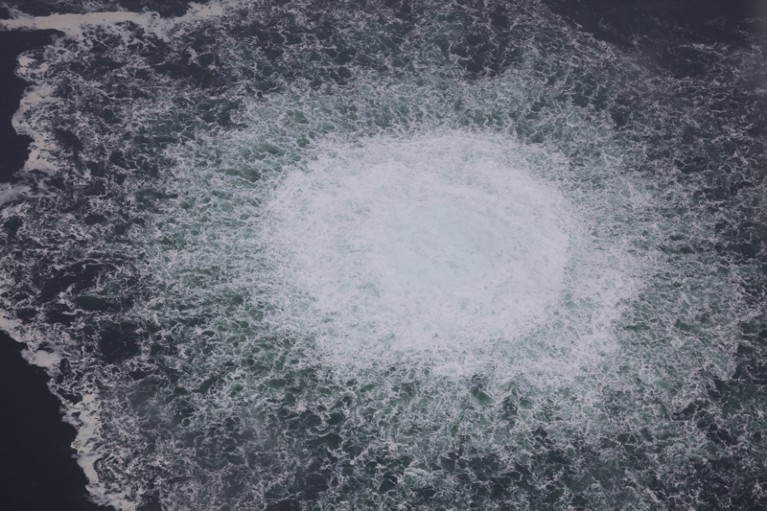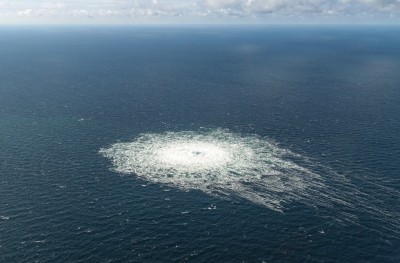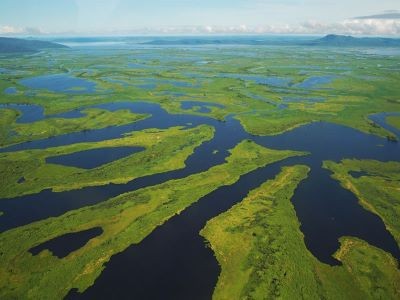[ad_1]

Bubbles of methane were visible on the surface of the Baltic Sea after explosions ruptured the Nord Stream gas pipelines.Credit: Swedish Coast Guard/Handout/Anadolu Agency/Getty
Researchers are rushing to find out whether explosions in the Nord Stream gas pipelines have caused further environmental chaos by stirring up pollutants from chemical weapons dumped after the Second World War.
The blasts that ruptured the pipelines in the Baltic Sea on 26 September happened very close to the Danish island of Bornholm, an area where stockpiled chemical warfare agents were dumped in 1947 as part of the post-war demilitarization of Germany.
What do Nord Stream methane leaks mean for climate change?
Around 32,000 tonnes of chemical weapons, containing around 11,000 tonnes of active chemical-warfare agents, were disposed of at the site, says Hans Sanderson, an environmental scientist at Aarhus University in Denmark. Over time, the metal casings of most of the discarded warheads have probably corroded, causing the contents to leach out into the surrounding sediment. Sanderson is concerned that the violent expulsion of methane from the ruptured pipeline might have sent those contaminants into the water column, where they could harm marine wildlife. The contaminants include the radioactive isotope caesium-137, toxic flame-retardant chemicals called polybrominated diphenyl ethers and heavy metals including mercury, cadmium and lead.
“The Baltic Sea is basically one of the most heavily polluted seas on the planet. So this sediment here is full of junk,” says Sanderson, who was involved in the environmental-impact assessment when the Nord Stream pipelines were originally laid. “These explosions [also] took place as close to the dump site of these chemical weapons as possible.”
‘Fluffy’ sediments
When he saw images of released methane bubbling up over a wide area around the ruptured pipeline, “I realized that there was a lot of sediment that will be thrown back up into the water column”, Sanderson says. “These sediments are very loose out there, so they’re fluffy and really mobile. So a lot of sediment can be resuspended.” His team is now using data from ongoing monitoring in the area to model the extent of sediment dispersal caused by the blasts. The group will then use toxicity thresholds for various marine species to investigate whether there is likely to have been any significant harm to marine life. The researchers have also begun taking samples of seawater and sediment from the area to improve the accuracy of their models.
Any sediment that has been disturbed will remain suspended in the seawater for a long time, says Sanderson. The Baltic Sea is relatively static, with no significant tides or currents. Furthermore, the temperature gradient in the water column means that the water is separated into layers that don’t mix well. “This plume is not just going to settle quickly again,” he says.
“I think there’s a cause for concern,” says Rodney Forster, a marine scientist at the University of Hull, UK, who has done a lot of work around the Baltic Sea. Given the size and scale of the methane leak, he says, “quite large amounts of sediment are going to be remobilized”.
Wider spread
The Baltic Sea has been trawled by fishing vessels for many years, which also disturbs the sediment. Ferdinand Oberle, a geologist at the US Geological Survey’s Pacific Coastal and Marine Science Center in Santa Cruz, California, has studied how bottom trawling has affected the sediment in this area. “Bottom trawling occurred frequently in the area of the Bornholm WWII dump site,” he says. Any sediment that had already been suspended in the water by this activity could now be spread farther by the blasts, he adds.
Scientists raise alarm over ‘dangerously fast’ growth in atmospheric methane
The potential damage to wildlife might be tempered by the timing of the explosion, says John Bothwell, a marine biochemist at Durham University, UK. “The cycles of marine life are usually starting to wind down for winter by mid-October,” he says. The blast site is in a cod-spawning area, but spawning usually happens in spring. “But there are still plenty of things that can be damaged: late algal blooms aren’t uncommon at this time of year, and those would have knock-on effects if damaged,” Bothwell adds.
Forster says that scientists based in countries bordering the area could provide useful data. “Germany, Sweden and Denmark have all got good research vessels in the area, surrounded by quite a high concentration of scientific activity.” Any sediment carried as far as the surface should be visible in images from satellites, Forster says.
The results will take time to come in, and Sanderson is anxious to see what they show. “I’m concerned about the fact that this is heavily polluted sediment,” he says, “and that this contaminated sediment will be bioavailable, and therefore potentially cause problems.”
“We just need to find out if this is the case or not — and right now, I don’t really know.”
[ad_2]
Source link



